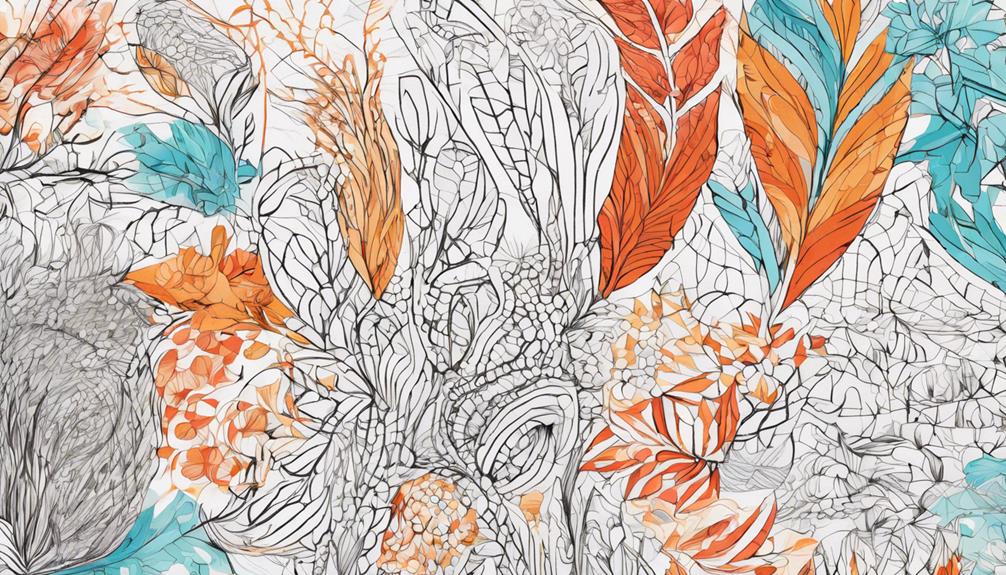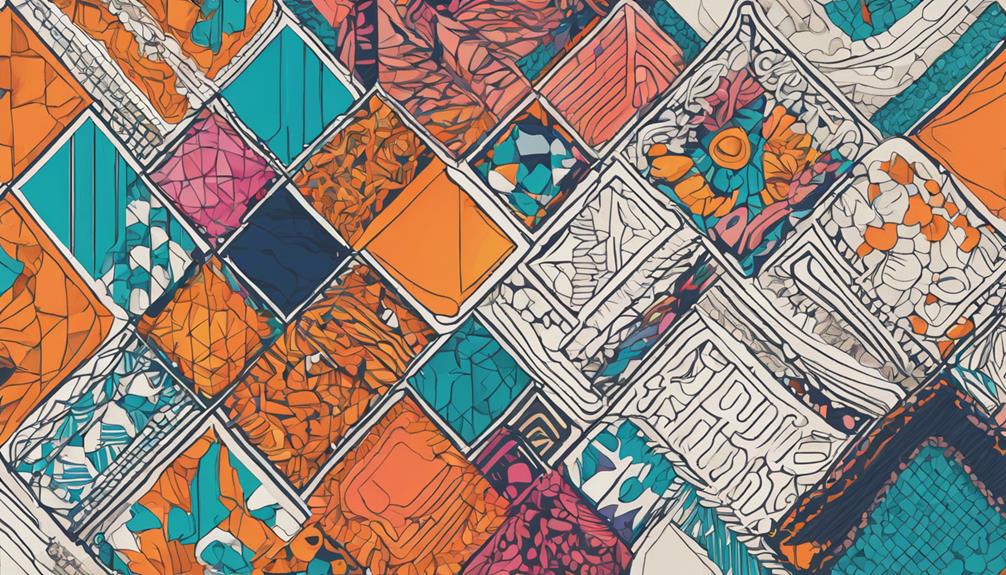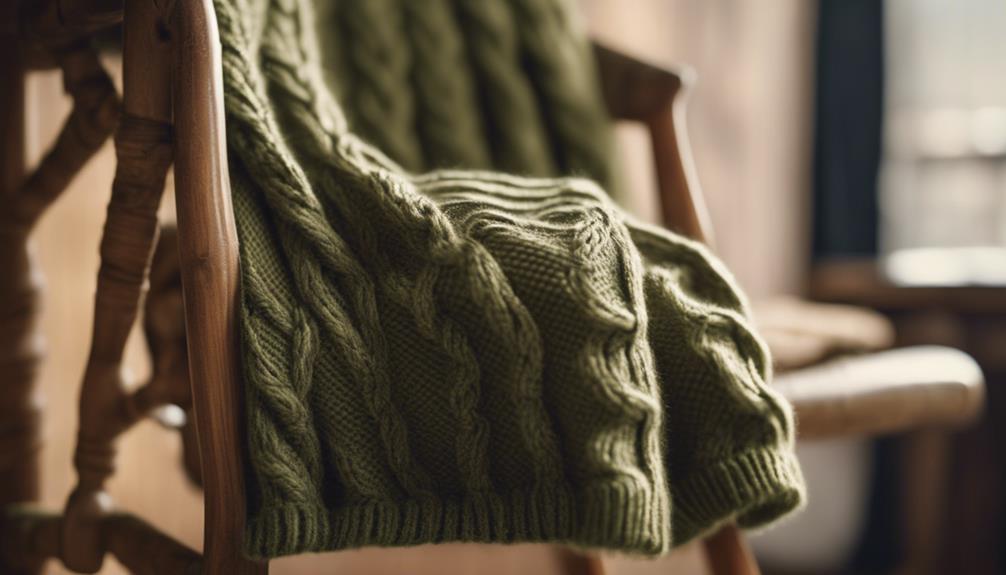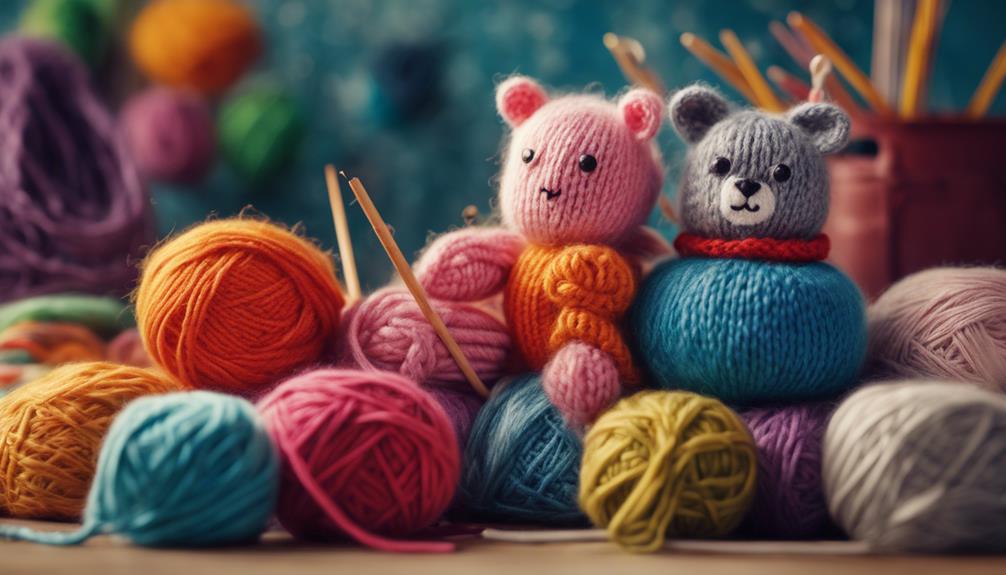Immerse yourself in the dynamic world of Philippine textile art! Discover the detailed handloom weaving, embroidery, and dyeing techniques that showcase the various cultural identities and traditions of the country. These fabrics not only embody the diverse heritage of the Philippines but also function as significant symbols of social status, prosperity, and tribal connections. Observe the expertise and symbolism entwined in every strand, narrating tales of Filipino culture and legacy. Embrace the cultural mosaic crafted through traditional approaches and modern advancements. Delve further into the realm of Philippine textile art and uncover a treasure trove of revelations ready to be unearthed!
Key Takeaways
- Filipino textile art encompasses handloom weaving, embroidery, and hand-dyeing techniques.
- Traditional textiles symbolize social status, wealth, and tribal affiliations.
- Weaving styles vary across regions like Ilocos, Visayas, and Mindanao.
- Filipino artisans preserve cultural heritage through weaving techniques.
- Contemporary artists blend traditional methods with modern design aesthetics.
Cultural Threads Revealed
Explore the rich tapestry of Filipino culture as Cultural Threads Revealed showcase the intricate artistry of traditional textile techniques. Traditional Filipino textiles, with their handloom weaving, embroidery, and hand-dyeing methods using materials like cotton, abaca, and piña, are a reflection of the country's vibrant heritage.
Contemporary Filipino artists continue to master these traditional weaving techniques, infusing them with modern creativity and innovation.
Through the skilled hands of these artisans, garments made from Filipino textiles become more than just fabric; they're symbols of social status, wealth, and tribal affiliation. The intricate patterns and vibrant colors woven into these textiles hold deep cultural significance, connecting communities with their past and traditions.
From ceremonial wear for weddings to festive attire for celebrations, these textiles play an essential role in preserving Filipino heritage and honoring ancestors.
As conservation efforts face challenges like urbanization and climate change, initiatives such as educational workshops and craft fairs are pivotal in promoting traditional weaving and supporting local artisans.
The Essence Of Philippine Textile Art

You can explore the essence of Philippine textile art by understanding its cultural symbolism, the artistic techniques and methods used, and its profound social impact and significance.
These elements intertwine to create a rich tapestry of tradition, creativity, and heritage that's deeply rooted in Philippine society.
Through textiles, the Filipino people express their history, values, and identities in intricate patterns and vibrant colors.
Cultural Symbolism in Textiles
The essence of Philippine textile art lies in its intricate cultural symbolism, reflecting social status, wealth, and heritage through unique patterns and designs.
Traditional textiles in the Philippines serve as powerful symbols of Filipino identity, weaving stories of tribal affiliations and community connections.
These fabrics aren't merely garments but essential elements in ceremonies, festivals, and daily wear, showcasing the wearer's heritage and social rank.
As conservation efforts face challenges like urbanization and economic pressures, promoting and supporting traditional weaving practices becomes essential.
Artistic Techniques and Methods
Artisans in the Philippines intricately employ handloom weaving, embroidery, and hand-dyeing techniques, using common materials like cotton, abaca, and piña fibers to create unique textile art that reflects the rich cultural heritage of the nation.
These traditional methods are deeply rooted in Filipino culture and history, showcasing a profound connection to the country's identity. Natural dyes sourced from plants and minerals, such as indigo, are often utilized to enhance the vibrant colors present in Filipino textiles.
Handloom weaving in Philippine textile art is characterized by elaborate patterns and designs, each telling a story that's intertwined with the cultural tapestry of the Philippines. The artistic techniques and methods utilized in Philippine textile art not only demonstrate the skill and creativity of the artisans but also serve as a tribute to the enduring legacy of craftsmanship passed down through generations.
Social Impact and Significance
Amidst diverse cultural influences, Philippine textile art intricately weaves together societal status, historical heritage, and communal connections.
The social impact and cultural significance of traditional Filipino textiles are profound, shaping identities and fostering community bonds.
Here are key points to note:
- Philippine textile art serves as a social marker denoting status, wealth, and tribal affiliation through distinct patterns.
- Garments made for weddings and festivals hold cultural and ceremonial significance, connecting communities with their ancestors.
- Conservation efforts face challenges like urbanization, climate change, and economic pressures, requiring promotion through workshops and government support.
- Textiles play a crucial role in ceremonies, festivals, and daily wear, reflecting wealth, heritage, and social rank in Filipino culture.
- Appreciating Filipino textiles preserves traditions, craftsmanship, and cultural heritage, supporting the nation's artistry and unique stories.
Historical Weave Of Filipino Textiles

Exploring the intricate historical weave of Filipino textiles reveals a tapestry of diverse regional weaving styles and cultural influences. Traditional textiles in the Philippines boast a rich history, with weaving techniques varying across regions like Ilocos, Visayas, and Mindanao.
Pre-colonial fabrics were celebrated for their elaborate designs, while Spanish rule introduced silk and embroidery methods to Filipino weavers, enriching the traditional artistry.
For centuries, fabrics made of abaca, cotton, and piña (pineapple fiber) have been prevalent, embodying the diverse cultural heritage of the Philippines. These materials not only serve as a means of clothing but also as a reflection of the country's intricate social tapestry.
The regional diversity in weaving styles underscores unique cultural traditions, where patterns and motifs often signify social standing and cultural identity. Essentially, the historical weave of Filipino textiles encapsulates generations of indigenous craftsmanship, colonial influences, and regional artistry, forming a vibrant cultural mosaic that continues to flourish.
Diverse Fibers, Diverse Cultures

Exploring the world of textile art in the Philippines reveals an engaging interplay between diverse fibers and rich cultural backgrounds. Contemporary Filipino artists continue to draw inspiration from the traditional art forms of indigenous peoples, creating a dynamic fusion of old and new in their creations.
- Abaca, Cotton, and Piña Fibers: These fibers hold unique cultural significance and are commonly used in Filipino textile art.
- Indigenous Weaving Traditions: Communities across the Philippines have a long-standing tradition of weaving fibers into intricate pieces that reflect their cultural heritage.
- Regional Weaving Styles: Different regions like Ilocos, Visayas, and Mindanao showcase distinct weaving styles, highlighting the diversity of cultural heritage in the country.
- Historical Influences: Fabrics like piña cloth and jusi blend historical influences from Spanish and Chinese cultures into Filipino textiles.
- Social and Cultural Symbolism: Traditional Filipino textiles symbolize social status, wealth, and tribal affiliation, with patterns serving as markers of identity and standing in society.
Symbolism And Social Significance

Traditional Filipino textiles carry profound symbolism and social significance within the diverse cultural landscape of the Philippines. These textiles symbolize status, wealth, and tribal affiliation, with distinct patterns indicating social standing within communities. Garments crafted from these textiles hold cultural and ceremonial importance, linking wearers to their heritage and ancestors during significant events such as weddings and festivals.
Beyond mere fabric, traditional Filipino textiles represent a tapestry of stories, craftsmanship, and cultural identity passed down through generations.
Appreciating and conserving these textiles is essential, as they not only honor tradition and craftsmanship but also support the nation's unique artistry and cultural heritage for future generations to appreciate. However, preservation efforts face challenges from urbanization, climate change, and economic pressures, necessitating support through workshops, government initiatives, and NGO programs.
Masters Of The Loom

Skilled artisans known as masters of the loom in the Philippines intricately weave traditional textiles using a variety of fibers like abaca, cotton, and pineapple. These artisans are revered for their expertise in weaving techniques that have been passed down through generations, resulting in fabrics with vibrant colors and intricate patterns. Filipino weavers take pride in incorporating symbolic motifs into their textiles, symbolizing social status, tribal affiliations, and historical narratives.
The art of traditional weaving in the Philippines is deeply intertwined with cultural traditions, serving as a powerful reflection of the rich heritage and identity of different indigenous groups. Through their craft, these masters of the loom play a crucial role in preserving ancient techniques and ensuring that cultural knowledge is transmitted from one generation to the next.
- Filipino artisans weave using a variety of fibers such as abaca, cotton, and pineapple.
- Traditional weaving techniques are passed down through generations in the Philippines.
- Symbolic motifs are commonly incorporated into Filipino textiles.
- Weaving in the Philippines reflects the rich heritage and identity of indigenous groups.
- The art of weaving serves as a means of preserving cultural knowledge in the country.
Contemporary Textile Art Scene

You'll discover how modern textile techniques, artistic material innovations, and cultural weaving expressions intertwine in the contemporary textile art scene of the Philippines.
Filipino textile artists are blending traditional methods with contemporary design influences to create unique and sustainable artworks.
Through a diverse range of cultural influences and artistic expressions, the textile art exhibitions in the Philippines showcase both established and emerging artists who are pushing boundaries in the field.
Modern Textile Techniques
Filipino contemporary textile artists are pushing boundaries by experimenting with handloom weaving, embroidery, and dyeing techniques to create innovative modern pieces. They combine traditional materials such as abaca, cotton, and piña (pineapple fiber) with natural dyes to achieve vibrant colors.
In the contemporary textile art scene of the Philippines, artists showcase intricate patterns and innovative designs that blend traditional techniques with modern creativity. Local artists incorporate indigenous weaving styles and materials into their work, emphasizing the rich cultural heritage of Filipino textiles.
This fusion of traditional craftsmanship with contemporary trends not only promotes the preservation of textile traditions but also allows for their evolution.
- Artists experiment with handloom weaving, embroidery, and dyeing techniques.
- Traditional materials like abaca, cotton, and piña are used alongside natural dyes.
- Intricate patterns and innovative designs are showcased in contemporary textile art.
- Indigenous weaving styles and materials are incorporated into modern pieces.
- The fusion of traditional craftsmanship with contemporary trends promotes the preservation and evolution of textile traditions.
Artistic Material Innovations
In the field of contemporary textile art in the Philippines, artists are breaking new ground by integrating innovative materials such as recycled plastics, metal wires, and digital prints into their creations. These Contemporary Filipino artists are challenging traditional weaving techniques by incorporating unconventional materials, leading to a vibrant and dynamic art scene.
By merging traditional practices with modern elements, they produce unique pieces that reflect a fusion of cultural heritage and sustainability practices. The use of unconventional materials not only pushes boundaries in the artistic domain but also showcases the evolving creativity and diversity within the Philippine art scene.
This experimentation with new materials and techniques adds depth and complexity to the artworks, sparking conversations and offering fresh perspectives on textile art. Through this exploration, artists are redefining the narrative of textile art in the Philippines, blending tradition with innovation to create thought-provoking and visually stunning pieces.
Cultural Weaving Expressions
Exploring the rich tapestry of cultural weaving expressions in contemporary textile art in the Philippines reveals a vibrant fusion of tradition and innovation. Filipino artists are at the forefront of this movement, blending traditional weaving techniques with modern design aesthetics to create enchanting pieces.
Here are some key points that highlight the dynamic landscape of contemporary textile art in the Philippines:
- Innovation in Materials: Filipino artists experiment with new materials, pushing the boundaries of traditional weaving.
- Colorful Creations: Vibrant colors and intricate patterns are hallmarks of Filipino contemporary textile art.
- Cultural Fusion: The art scene reflects a vibrant mix of heritage and modern influences.
- Sustainability and Social Impact: Weavers and designers collaborate to incorporate sustainability and social impact into their creations.
- Global Recognition: Emerging Filipino textile artists are gaining international acclaim for their innovative approaches, putting Philippine textile art on the global stage.
Conservation And Revival Efforts

Efforts to conserve and revive textile art in the Philippines face various challenges such as urbanization, climate change, and economic pressures. These challenges threaten the traditional weaving practices that have been passed down through generations. However, there's a glimmer of hope through initiatives led by local artisans and NGOs.
Educational workshops, government programs, and craft fairs play an essential role in promoting traditional weaving and supporting the livelihoods of local artisans.
Philippine textiles not only serve as symbols of status, wealth, and tribal affiliation but also hold significant cultural and ceremonial importance. Garments worn during weddings and festivals connect communities with their ancestors, highlighting the deep-rooted traditions embedded in these textiles.
To safeguard the preservation of Filipino textile heritage, ongoing efforts are needed to raise awareness through workshops, garner government support, and collaborate with NGOs dedicated to protecting these invaluable cultural assets.
Experiencing Textile Art

Discover the immersive world of Filipino textile art through vibrant patterns and intricate designs that reflect the country's rich cultural heritage.
Contemporary Filipino artists incorporate traditional techniques and motifs to tell stories that have been passed down through generations.
By exploring Filipino textile art, you can gain a deeper understanding of how these fabrics serve as social markers, denoting status, wealth, and tribal affiliation within the community.
The experience of witnessing these textiles in person allows you to appreciate the skill and creativity of the artisans who meticulously craft each piece.
Through these artworks, you can explore the historical context and learn about the social order that these textiles once represented.
Immerse yourself in the beauty and cultural significance of Filipino textile art to truly appreciate the intricate craftsmanship and storytelling woven into each fabric.
Join The Conversation

Engage in dialogues surrounding Filipino textile art to deepen your appreciation for its cultural significance and artistic complexity. Contemporary Filipino artists are reimagining traditional materials like abaca, cotton, and pineapple fiber to create innovative pieces that honor the rich heritage of Philippine textile art. By exploring these modern interpretations, you can gain a fresh perspective on how age-old techniques are being revitalized in today's context.
To further enrich your understanding, consider the regional variations in weaving styles across the Philippines. From the intricate patterns of the Cordilleran textiles to the vibrant hues of the T'boli weaves, each region offers a unique glimpse into the diverse cultural tapestry of the country. By delving into these nuances, you can appreciate the craftsmanship and heritage embedded in every thread.
| Region | Weaving Style | Material Used |
|---|---|---|
| Cordillera | Intricate patterns | Abaca, cotton |
| Mindanao | Vibrant colors | Pineapple fiber |
| Visayas | Geometric designs | Silk |
| Luzon | Nature-inspired motifs | Looms |
| Bicol | Bold and abstract compositions | Natural dyes |
Frequently Asked Questions
What Is the Textile of the Philippines?
The textile of the Philippines encompasses a diverse range of fabrics like piña and jusi, woven from pineapple fibers and silk. These textiles reflect historical Spanish and Chinese influences, shaping traditional Filipino clothing styles such as the barong and pañuelo.
Imported fabrics have played a significant role in the construction of these garments, highlighting the interconnectedness of global textile traditions. Fabrics like piña cloth and jusi hold deep cultural significance in the Philippines, with roots in European fashion influences.
How Important Is the Philippines Textile Art in Our Country?
In your country, Philippine textile art plays a pivotal role in preserving cultural heritage. Its significance lies in symbolizing social status, showcasing craftsmanship, and representing cultural identity.
The intricate patterns and vibrant colors in Filipino textiles demonstrate the artistry of handloom weaving, embroidery, and hand-dyeing techniques.
Conservation efforts are essential to safeguard this living tradition against modern challenges, ensuring its continued legacy and cultural richness.
What Is the Cultural Significance of Textiles?
Textiles hold immense cultural significance, serving as symbols of social status, heritage, and community ties. Traditional weaving techniques and vibrant colors in fabrics reflect craftsmanship and storytelling traditions.
Fabrics made from diverse materials showcase regional weaving styles, highlighting the unique cultural heritage of different Philippine communities.
Despite challenges like urbanization and climate change, efforts to preserve these textiles are essential in safeguarding this rich cultural legacy for future generations.
What Is the Significance of Textile Art?
Textile art holds immense importance, weaving together history, culture, and identity. Fabrics serve as markers of wealth and social status, reflecting heritage and tradition.
Artisans employ diverse methods like weaving and dyeing to create unique pieces. Regional variations highlight distinct cultural heritages. Conservation efforts face challenges but are essential to preserving these rich traditions.
Embracing and supporting textile art is essential for safeguarding this integral part of Filipino heritage.
Conclusion
So, you've explored the intricate world of Philippine textile art and discovered the depth of cultural meaning behind each thread. Now, your journey has just begun – unraveling the fabric of history, symbolism, and creativity woven into every piece.
Keep exploring, keep learning, and keep embracing the rich tapestry of Filipino heritage through textile art. The more you learn, the more you'll realize that there's always more to discover beneath the surface threads.










